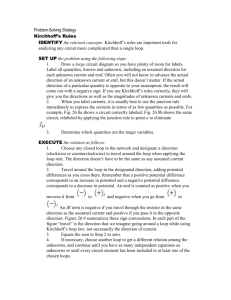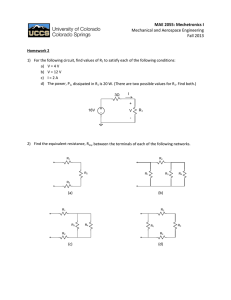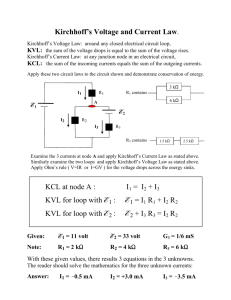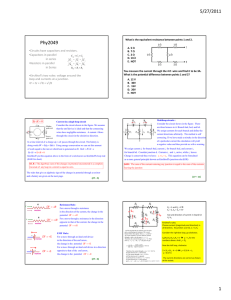** Disclaimer: This lab write-up is
advertisement
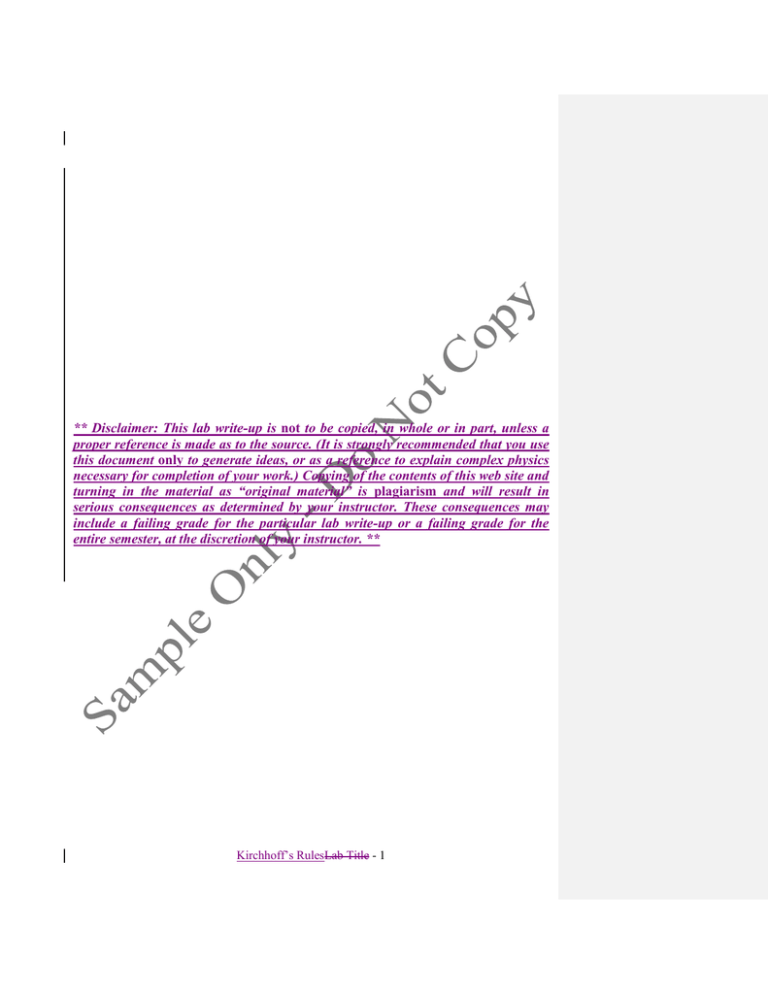
** Disclaimer: This lab write-up is not to be copied, in whole or in part, unless a proper reference is made as to the source. (It is strongly recommended that you use this document only to generate ideas, or as a reference to explain complex physics necessary for completion of your work.) Copying of the contents of this web site and turning in the material as “original material” is plagiarism and will result in serious consequences as determined by your instructor. These consequences may include a failing grade for the particular lab write-up or a failing grade for the entire semester, at the discretion of your instructor. ** Kirchhoff’s RulesLab Title - 1 Kirchhoff’s Rules Name: PES 215 Report Lab Station: Objective The purpose of this lab was to explore the rules of potential and current in a circuit as provided Formatted: Indent: First line: 0" by Kirchhoff’s Rules. This included building a circuit with resistor in series and parallel to test the various aspects of Kirchhoff’s Rules. This day has been a long time coming, but it is finally time for you to leave the nest and try writing the reports on you own! Data and Calculations Part A – Checking the Components: There were three resistors that we used for the different circuits in this lab. We used the color coded bands printed on the resistors to determine the resistance and then measured the actual resistance of the resistor using the DMM setup as an Ohmmeter. Formatted: Font: Not Bold Formatted: Left Formatted: Font: Not Bold Resistor Number 1 2 3 Band Colors Color Code Resistance [Ω] DMM Measured Resistance [Ω] Brown-BlackYellow-Gold Brown-BlackOrange-Gold Brown-BlackRed-Gold 100,000 Ω 100. kΩ 10,000 Ω 10.0 kΩ 1,000 Ω 1.00 kΩ For all calculations in Parts B – D we will use the DMM Measured Resistance of the resistors. Part B – Resistors in Series: For this part of the lab we were trying to prove Kirchhoff’s Zeroth Rule and Kirchhoff’s Loop Rule for resistors in series. Kirchhoff’s RulesLab Title - 2 We first assembled a circuit with resistors in series. This is represented in the following circuit diagram: Figure 1: Circuit diagram of resistors 2 and 3 set up in series. We used an adjustable power supply, the 10kΩ resistor, the 100kΩ resistor, and a circuit board to build the circuit above. Formatted: Left Part B-1: Does Kirchhoff’s Zeroth Rule hold? Formatted: Left We wanted to determine the current through various wires in the circuit above, as well as the potential drops and increases across the various components. We did this by creating three separate cases – with the ampmeter positioned at various locations around the circuit. Each of these three cases is described below. We removed the short wire on the circuit board where the ampmeter needed to go and connected in the ampmeter to measure the current though the circuit at that part. Case 1: Ampmeter before Both Resistors: Figure 2: Circuit diagram of resistors 2 and 3 set up in series with Ampmeter measuring current before both resistors Current through the Circuit [A] 90.91 μA Kirchhoff’s RulesLab Title - 3 Case 2: Ampmeter between Resistors: Figure 3: Circuit diagram of resistors 2 and 3 set up in series with Ampmeter measuring current between the two resistors Current through the Circuit [A] 90.90 μA Case 3: Ampmeter after Both Resistors: Figure 4: Circuit diagram of resistors 2 and 3 set up in series with Ampmeter measuring current after both resistors Current through the Circuit [A] 90.91 μA Kirchhoff’s Zeroth rule states: The current does not change around a corner in a circuit diagram. Kirchhoff’s RulesLab Title - 4 Figure 5: Circuit diagram of two resistors set up in series with current flowing through the circuit following Kirchhoff’s Zeroeth Rule I case1 I case2 I case3 In our case, the circuit diagram for resistors in series does not have any junctions (only corners); thus, Kirchhoff’s Zeroth rule would appear to be applicable for this circuit. So, for Kirchhoff’s Zeroth rule to hold, all the currents (assuming the resistors are not changed and the EMF is relatively the same) should be equal. ? ? I case1 I case 2 I case3 Case 1: Current through the Circuit [A] 90.91 μA Case 2: Current through the Circuit [A] 90.90 μA Case 3: Current through the Circuit [A] 90.91 μA To prove Kirchhoff’s Zeroeth rule, we check to see if the 3 currents measured around the circuit are equal: ? ? 90.91 [A] 90.90 [ A] 90.91 [ A] 90.91 [A] 90.90 [A] 90.91 [A] Note that since the values we obtained are VERY NEARLY equal, we can confidently state that Kirchhoff’s Zeroth Rule holds. Note that if we had “more accurate” readings that the answer would likely be even closer to equality – but due to rounding and other mechanical random errors (e.g. resistors’ errors) it may not be equal exactly. (Another likely error could be from small changes in the EMF from case 1 to case 3.) Part B-2: Does Kirchhoff’s Loop Rule hold? Kirchhoff’s Loop rule states: The sum of the potential increases and drops around a closed loop add up to zero. Kirchhoff’s RulesLab Title - 5 n V i 1 i 0 Figure 6: Circuit diagram of two resistors with Kirchhoff’s Rule problem solving techniques applies Potential Rise from Voltage Supplied (EMF) [V] 10.00 V Potential Drop Across 10kΩ [V] -0.9091 V Potential Drop Across 100kΩ [V] -9.091 V (Note: Recall that Potential increases (e.g., EMF) typically have a “+” sign to indicate increase where potential drops typically have a “–“ sign to indicate decrease when traversing around a closed circuit in the same direction as the current.) In our case, we have one potential rise (the voltage supplied) and two separate potential drops (the drop across the 10kΩ and 100kΩ resistors). So, for Kirchhoff’s Loop Rule to hold, the sum of the potential rises and decreases around a closed loop must be (very nearly) zero. 3 V i 1 i ? V10k V100k 0 Plugging in the numbers I have in the table above: ? V10k V100k 0 ? 10.00 [ V ] 0.9091 [V ] 9.091 [ V ] 0.0001 [ V ] 0 0.0001 [V ] 0 Since the value of the sum we obtained is VERY NEARLY zero, we can confidently state that Kirchhoff’s Loop Rule holds. Note that if we had “more accurate” readings that the answer Kirchhoff’s RulesLab Title - 6 would likely be even closer to zero – but due to rounding and other mechanical random errors (e.g. resistors’ errors) it may not be zero exactly. Another method for proving Kirchhoff’s Loop Rule is by using the Problem Solving Techniques from the pre-lab. This gives the following relationship: Formatted: Font: Not Bold I1 R1 R2 Formatted: Font color: Red, Lowered by 5 pt 10.00 V 90.905A10000 100000 9.99955 V Formatted: Font color: Red, Lowered by 5 pt 10.00 V 9.99955 V Formatted: Font color: Red, Lowered by 5 pt ? ? Formatted: Centered Formatted: Indent: Left: 0", First line: 0" Since the evaluation provided by analyzing this circuit provides VERY NEARLY equal values, we can confidently state that Kirchhoff’s Loop Rule holds. Part C – Resistors in Parallel: For this part of the lab we were trying to prove Kirchhoff’s Zeroth Rule, Kirchhoff’s Loop Rule, and Kirchhoff’s Junction Rule for resistors in parallel. We first assembled a circuit with resistors in parallel. This is represented in the following circuit diagram: Note that there are two distinct junctions in the circuit diagram above. These occur at: 1) junction b and 2) junction e. We will test Kirchhoff’s Junction Rule for currents at both of these junctions for the current(s) flowing into the junction and the current(s) flowing out of the junction. Again, we used an adjustable power supply, a 10kΩ resistor, a 100kΩ resistor, and the circuit board to build the circuit above. Formatted: Left Part C-1: Does Kirchhoff’s Zeroth Rule hold? Formatted: Left Kirchhoff’s RulesLab Title - 7 We wanted to determine the current through various wires in the circuit above, as well as the potential drops and increases across the various components. We did this by creating four separate cases – with the ampmeter positioned at various locations around the circuit. Each of these four cases is described below. Case 1: Ampmeter before Both Resistors: Current through the Circuit [A] 1.1 mA Case 4: Ampmeter after Both Resistors: Current through the Circuit [A] 1.1 mA Part C-2: Does Kirchhoff’s Junction Rule hold? Case 3: Ampmeter before/after 10kΩ Resistor: Kirchhoff’s RulesLab Title - 8 <Add descriptive text about what you had to do to build the following circuit. Was there anything special you needed to do? Did you have to completely re-build the circuit?> Current through the Circuit [A] 1.0 mA Case 3: Ampmeter before/after 100kΩ Resistor: <Add descriptive text about what you had to do to build the following circuit. Was there anything special you needed to do? Did you have to completely re-build the circuit?> Current through the Circuit [A] 0.09 mA <Notice anything in particular about the potential drop across resistors in parallel? Maybe something related to the EMF?> Part C Further Analysis: <Overall does Kirchhoff’s Junction Rule hold for resistors in parallel? Does the current though the circuit case 1 = case 2 + case 3 and case 4 = case 2 + case 3?> Kirchhoff’s RulesLab Title - 9 Kirchhoff’s Junction Rule states: The sum of the currents into a junction point must equal the sum of the current out of a junction point. n I j 1 m In , j I Out,k k 1 In our case, we have two distinct junction points (junction b and junction e). So, for Kirchhoff’s Junction Rule to hold, the sum of the currents into junction b (or junction e) must equal the sum of the currents out of junction b (or junction e). Junction b: There is one current going into junction b. This is the current from case 1 above. Likewise, there are two currents going out of junction b. These are the currents from case 2 and case 3 respectively. Thus, according to Kirchhoff’s Junction Rule: ? I Case1 I Case2 I Case3 Case 1: Current through the Circuit [A] 1.1 mA Case 2: Current through the Circuit [A] 0.09 mA Case 3: Current through the Circuit [A] 1.0 mA ? 1.1 [mA] 0.09 [mA] 1.0 [mA] 1.1 [mA] 1.09 [mA] <Again note that since the values we obtained are VERY NEARLY equal, we can confidently state that Kirchhoff’s Junction Rule holds. Note that if we had “more accurate” readings that the answer would likely be even closer to equality – but due to rounding and other mechanical random errors (e.g. resistors’ errors) it may not be equal exactly. Another likely error could be from changing the EMF from case 1, to case 2, to case 3.> Junction e: Kirchhoff’s RulesLab Title - 10 There are two currents going into junction e. This is the current from case 3 and case 3 above. Likewise, there is one current going out of junction e. This is the currents from case 4. Thus, according to Kirchhoff’s Junction Rule: ? I Case2 I Case3 I Case4 Case 2: Current through the Circuit [A] 0.09 mA Case 3: Current through the Circuit [A] 1.0 mA Case 4: Current through the Circuit [A] 1.1 mA ? 1.1 [mA] 0.09 [mA] 1.0 [mA] 1.1 [mA] 1.09 [mA] Formatted: Centered <Again note that since the values we obtained are VERY NEARLY equal, we can confidently state that Kirchhoff’s Junction Rule holds. Note that if we had “more accurate” readings that the answer would likely be even closer to equality – but due to rounding and other mechanical random errors (e.g. resistors’ errors) it may not be equal exactly. Another likely error could be from changing the EMF from case 1, to case 2, to case 3.> Part C-3: Does Kirchhoff’s Loop Rule hold? Potential Rise from Voltage Supplied (EMF) [V] 10.07 V Potential Drop Across 10kΩ [V] -10.07 V Kirchhoff’s RulesLab Title - 11 Formatted: Left Potential Drop Across 100kΩ [V] -10.07 V Kirchhoff’s Loop rule states: The sum of the potential rises and decreases around a closed loop must be zero. n V i 1 i 0 In our case, we have three separate loops (a-b-e-f-a, a-b-c-d-e-f-a, and b-d-c-e-b). So, for Kirchhoff’s Loop Rule to hold, the sum of the potential rises and decreases around a closed loop must be (very nearly) zero. For loop a-b-e-f-a: 2 V i i 1 ? V10k 0 ? V10k 0 ? 10.07 [V ] 10.07 [V ] 0.0 [V ] 0 0.0 [V ] 0 For loop a-b-c-d-e-f-a: 2 V ? i i 1 V100k 0 ? V100k 0 ? 10.07 [V ] 10.07 [V ] 0.0 [V ] 0 0.0 [V ] 0 For loop b-c-d-e-b: 2 V i 1 i ? V10k V100k 0 <Notice since the traverse of the 10kΩ resistor is in the opposite direction of the current flowing though that resistor we must have a negative sign in there. Using the numbers I have in the example above:> Kirchhoff’s RulesLab Title - 12 ? V10k V100k 0 10.07 [ V ] 10.07 [V ] 0.0 [V ] 0 ? 0.0 [V ] 0 <And since ALL the values we obtained are all VERY NEARLY zero, we can confidently state that Kirchhoff’s Loop Rule holds. Note that if we had “more accurate” readings that the answer would likely be even closer to zero – but due to rounding and other mechanical random errors (e.g. resistors’ errors) it may not be zero exactly.> Part D – A Little Bit of Everything: PST 9 - Apply the Loop Rule for each closed loop in the circuit diagram (use Ohm’s Law as described at the beginning of this pre-lab): We have 3 loops that we need to consider each individually. These three loops are (using the letters to describe the loops): Loop 1 = a-b-c-d-g-f-e-a: Kirchhoff’s RulesLab Title - 13 Formatted: Indent: Left: 0", First line: 0" ** NOTE: we did not “get rid” of the wire connecting c to f, we just are “selectively ignoring” it at the moment since it plays no part in the loop we are concerned with. ** Applying Ohm’s Law using the convention set up at the beginning of the pre-lab: From a to b: V 0 From b to c: V1 I1 R1 (** NOTICE THAT IT IS NEGATIVE SINCE WE ARE TRAVERSING IN THE SAME DIRECTION AS THE CURRENT! **) From c to d: V 0 From d to g: V3 I 3 R3 From g to f: From f to e: V 0 V 0 From e to a: Kirchhoff’s RulesLab Title - 14 V4 According to the loop rule, the sum of the potential rises and decreases around a closed loop must be zero. n V i 1 7 V i 1 i i 0 0 I 1 R1 0 I 3 R3 0 0 0 I1 R1 I 3 R3 0 (eq. 1) Loop 2 = a-b-c-f-e-a: Applying Ohm’s Law using the convention set up at the beginning of the pre-lab: From a to b: V 0 From b to c: V1 I1 R1 From c to f: V2 I 2 R2 Kirchhoff’s RulesLab Title - 15 From f to e: V 0 From e to a: V4 According to the loop rule, the sum of the potential rises and decreases around a closed loop must be zero. n V i 1 5 V i 1 i i 0 0 I 1 R1 I 2 R2 0 0 I1 R1 I 2 R2 0 (eq. 2) Loop 3 = c-d-g-f-c: Applying Ohm’s Law using the convention set up at the beginning of the pre-lab: From c to d: From d to g: From g to f: V 0 V3 I 3 R3 V 0 From f to c: V2 I 2 R2 Kirchhoff’s RulesLab Title - 16 (** NOTICE THAT IT IS POSTIVE SINCE WE ARE TRAVERSING IN THE OPPOSITE DIRECTION THAN THE CURRENT! **) According to the loop rule, the sum of the potential rises and decreases around a closed loop must be zero. n V i 1 4 V i 1 i i 0 0 I 3 R3 0 I 2 R2 0 I 3 R3 I 2 R2 0 (eq. 3) PST 10 - Apply the Junction Rule for each junction in the circuit diagram: We have 2 junctions that we need to consider each individually. These two junctions are (using the letters to describe the junctions): Junction 1 @ c: According to the junction rule, the sum of the currents into a junction point must equal the sum of the current out of a junction point. I1 I 2 I 3 (eq. 4) Junction 1 @ f: According to the junction rule, the sum of the currents into a junction point must equal the sum of the current out of a junction point. I 2 I 3 I 4 (eq.5) Kirchhoff’s RulesLab Title - 17 PST 11 - Solve the system of equations for the knowns and unknowns: We are given the following information from the beginning of the problem: R1 R2 R3 10 V 10 kΩ 100 kΩ 1 kΩ That means that the unknowns are: I1 , I 2 , I 3 , and I 4 Here is the list of consolidated equations we found using the loop rule and junction rule on the circuit: I1 R1 I 3 R3 0 (eq. 1) I1 R1 I 2 R2 0 (eq. 2) I 3 R3 I 2 R2 0 (eq. 3) I1 I 2 I 3 (eq. 4) I 2 I 3 I 4 (eq.5) First, start by solving equation 3 for I3: I3 I 2 R2 (eq. 6) R3 Plug equation 6 into equation 1: I R I 1 R1 2 2 R3 0 R3 I1 R1 I 2 R2 0 Notice that this is exactly the same as equation 2! So at least we did the loop rules right! Look at equation 4 and equation 5. Notice that the sums are the same for both of those equations. This must mean that: Kirchhoff’s RulesLab Title - 18 I 1 I 4 (eq. 7) Use equation 4 and plug the value for I1 into equation 2: I 2 I 3 R1 I 2 R2 0 I 2 R1 I 3 R1 I 2 R2 0 (eq. 8) Use equation 6 and plug in the value of I3 into equation 8, then solve for I2: I R I 2 R1 2 2 R3 R1 I 2 R2 0 RR I 2 R1 1 2 R2 R 3 I2 I2 RR R1 1 2 R2 R 3 R3 R1 R3 R1 R2 R2 R3 Use the value we just found for I2 and plug it into equation 3, then solve for I3: R3 R2 0 I 3 R3 R R R R R R 1 2 2 3 1 3 I 3 R3 I3 R2 R3 R1 R3 R1 R2 R2 R3 R2 R1 R3 R1 R2 R2 R3 Use the values we have found for I2 and for I3 and plug them into equation 4, then solve for I1: I1 I 2 I 3 R3 R2 R1 R3 R1 R2 R2 R3 R1 R3 R1 R2 R2 R3 Kirchhoff’s RulesLab Title - 19 I1 I1 R3 R2 R1 R3 R1 R2 R2 R3 R2 R3 R1 R3 R1 R2 R2 R3 Use the value we have found for I1 and plug it into equation 7, then solve for I4: I1 I 4 I4 R2 R3 R1 R3 R1 R2 R2 R3 Now we have expressions for all four currents in the original circuit. I1 R2 R3 R1 R3 R1 R2 R2 R3 I2 R3 R1 R3 R1 R2 R2 R3 I3 R2 R1 R3 R1 R2 R2 R3 I4 R2 R3 R1 R3 R1 R2 R2 R3 We can now plug in the value of the given information and solve for the numerical value of each of the currents. I1 I1 10 V 100k 1k 10k1k 10k100k 100k1k 10 V 101000 10 V 101000 9 2 8 2 1 10 1 10 1 10 1110000000 2 7 2 I1 9.0991 10 4 A 0.90991 mA I2 I2 10 V 1k 10k1k 10k100k 100k1k 110 7 10 V 1000 10 V 1000 2 1 10 9 2 1 108 2 1110000000 2 I 2 9.009 10 6 A 9.009 A Kirchhoff’s RulesLab Title - 20 I3 I1 10 V 100k 10k1k 10k100k 100k1k 10 V 100000 10 V 100000 9 2 8 2 1 10 1 10 1 10 1110000000 2 7 2 I 3 9.009 10 4 A 0.9009 mA I4 I4 10 V 100k 1k 10k1k 10k100k 100k1k 110 7 10 V 101000 10 V 101000 2 1 10 9 2 1 108 2 1110000000 2 I 4 9.0991 10 4 A 0.90991 mA Finally, we can determine the potentials (voltages) across each of the components by Ohm’s Law. V1 I1 R1 V1 0.90991 mA10k 0.90991 10 3 A 1 10 4 V1 9.0991 V V2 I 2 R2 V2 9.009 A100k 9.009 10 6 A 1 105 V2 0.9009 V V3 I 3 R3 V3 0.9009 mA1k 0.9009 10 3 A 1 103 V3 0.9009 V V4 10 V Kirchhoff’s RulesLab Title - 21 Formatted: Indent: Left: 0.25" Formatted: Bullets and Numbering Additional Questions question 1 Formatted: Bullets and Numbering Conclusion You write the details. Include your answer here. Use complete sentences!!!! ** NOTE: There are several components of error which could significantly modify the results of this experiment. Some of these are listed below: Heat Age Humidity Short circuit Fuse Bad power supply (recall we used the DMM to attempt to alleviate this problem.) Bad connections (in protoboard) Insulation Length of wire and Gauge accuracy of wire (copper) ** Think lab 7 ** Bad power supply (recall we used the DMM to attempt to alleviate this problem.) Buckling, bending, etc… of wire Elemental components/material makeup of the wire ** Think lab 7 ** ?? It is recommended that you take these and explain the “why” part of each for your results and conclusions sections – and possibly what could have been done (if anything) to minimize the effects of these errors. Kirchhoff’s RulesLab Title - 22 Formatted: Bullets and Numbering


